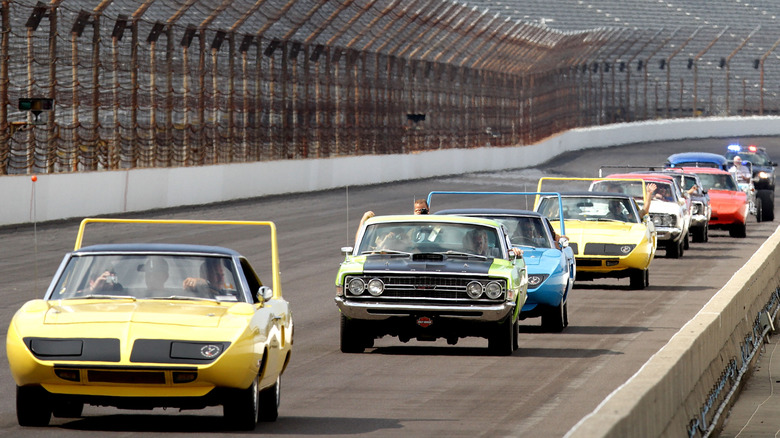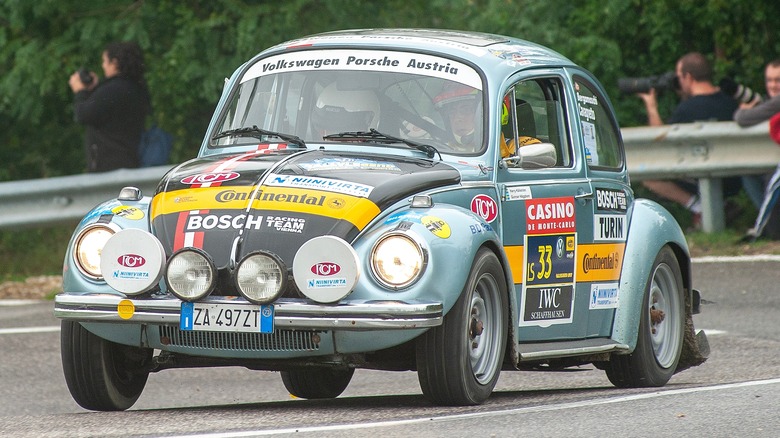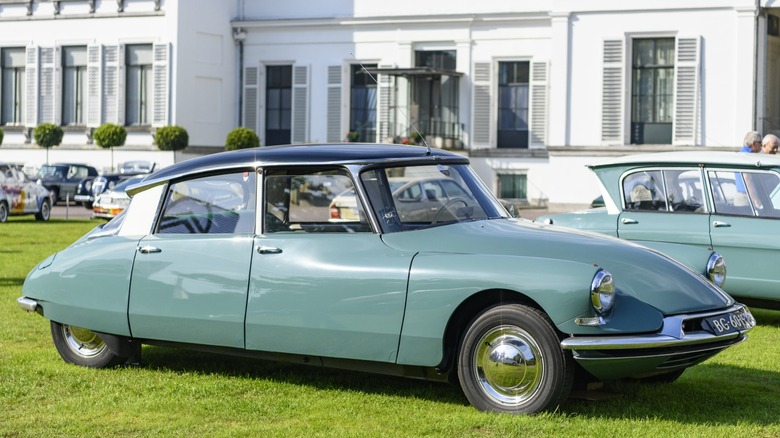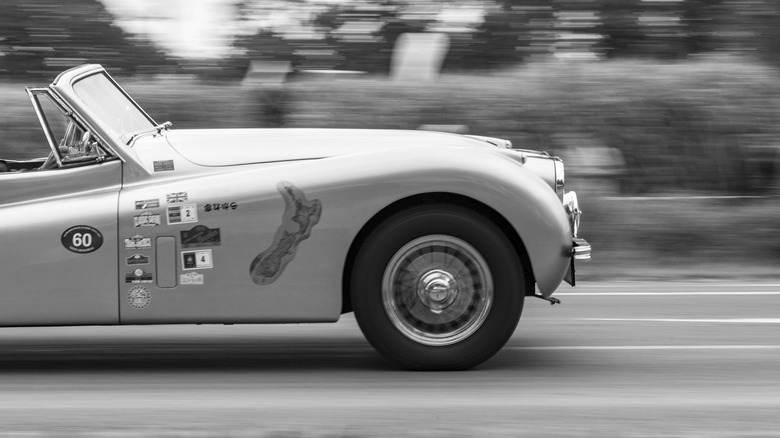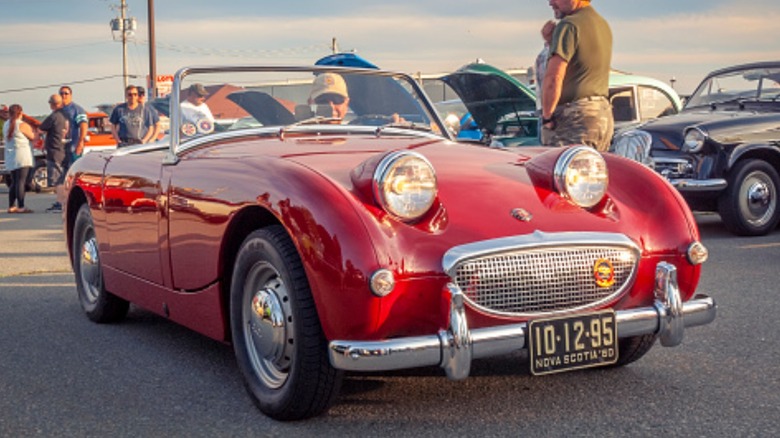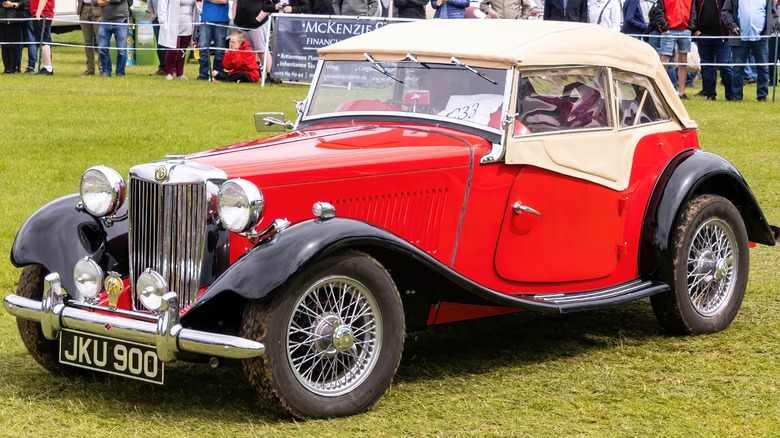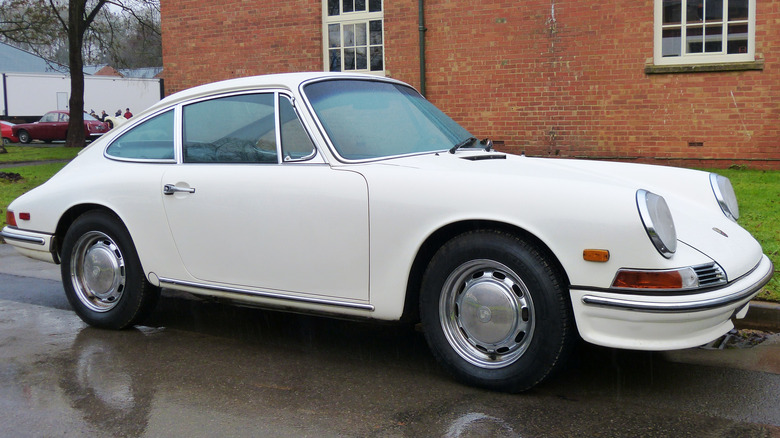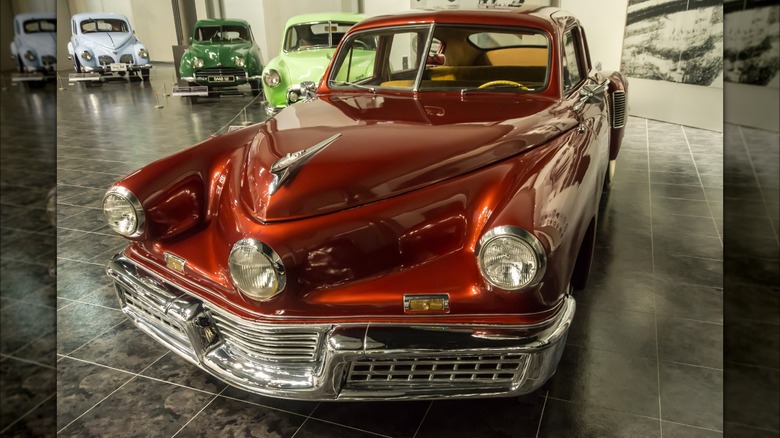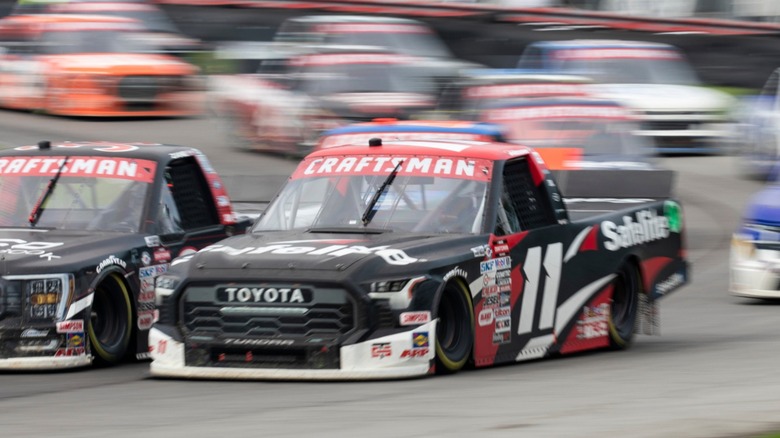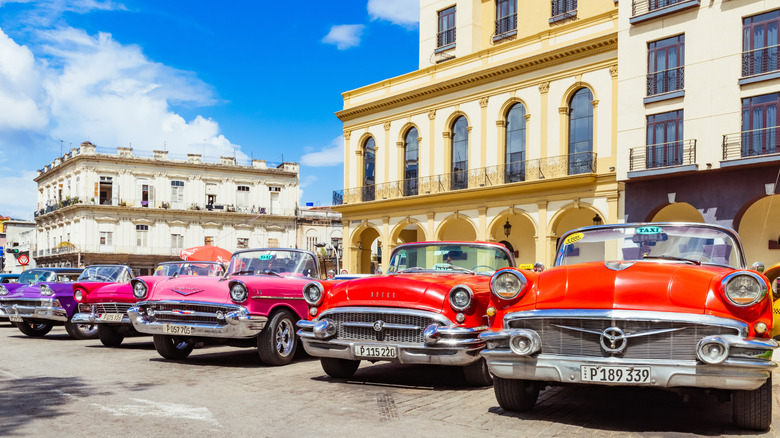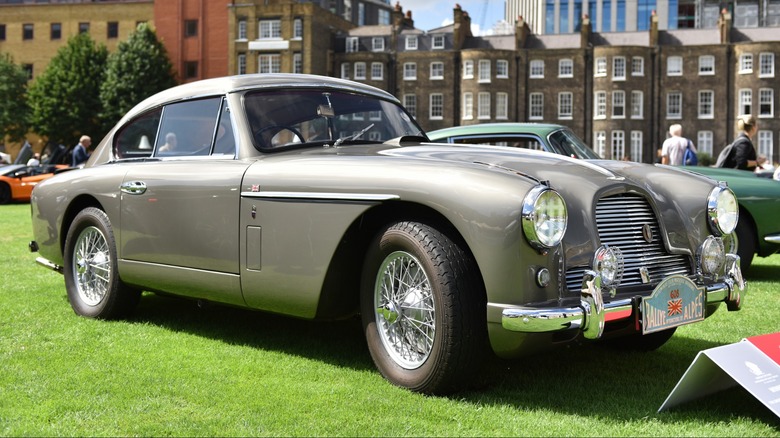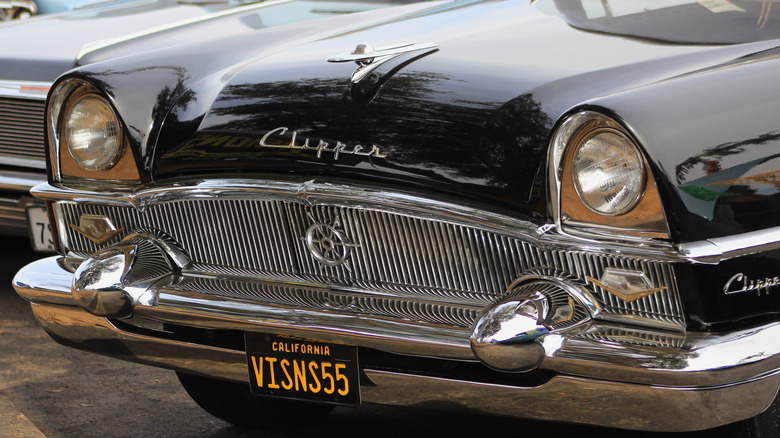10 Race Cars You Probably Had No Idea Competed In NASCAR
The most uniquely American automobile racing also happens to be its most popular, NASCAR. While other forms of racing began with wealthy car owners and early carmakers wanting to prove who has the best and fastest car, NASCAR's roots come from outlaws.
During prohibition, moonshiners started modifying and engine-swapping their cars to haul illicit liquor to the black market. They had to hone their driving skills to outrun the law, and their souped-up cars ensured success. Eventually, a Georgia bootlegger organized a stock car race in 1938 at the Atlanta Speedway, which proved successful and popular. The race continued until World War II interrupted everything, but after the war, the race organizers met to create the National Association For Stock Car Auto Racing.
NASCAR's early days were drastically different from the sport we have today. The first race was held on sand at Daytona Beach. Road courses made up several races and NASCAR hosted multiple classes of vehicles. Initially and for many years, a stock car meant exactly that — a car as it came from the factory. It took decades for the cars to become the sophisticated bespoke race cars built on tube-frame chassis we have today.
While Chevrolet, Ford, Dodge, and Buick have dominated the racing series since its inception, other manufacturers have joined at one time or another, including many from Europe. Some of the entries seem so far out of left field, you probably had no idea they ever raced in NASCAR. Here are 10 of them.
Volkswagen Beetle
If you are wondering what a Volkswagen Beetle was ever doing participating in NASCAR, it is possible the driver did, too. Yet, in 1953 and 1955, the thrifty little German car entered a NASCAR event. With just 36 horsepower, you might think the Beetle would be at a disadvantage to pretty much everybody. That was true, but driver Jim Graham, a San Fransisco VW dealer, felt the handling and reliability would gain enough of an advantage to overcome the lack of power. Furthermore, he said the tire wear should be less of a concern and he had expected the car to run the entire race without a pit stop.
While the VW failed to take any checkered flags it did manage a 6th and an 8th place finish in 1955. The 1953 entrant Dick Hagy managed a 19th-place finish in a field of 35 and won $40, and that's still pretty respectable considering the odds. Furthermore, a day before legendary driver Dale Earnhardt made his NASCAR debut, a Beetle raced in the Baby Grand Series, finishing 26th of 19 cars.
Citröen ID19
Throughout the 1950s, American cars with V8 engines dominated the sport, with the notable exception of The Fabulous Hudson Hornet and its legendary six-cylinder. That is why it might seem odd to see a quirky French front-wheel-drive car with no more than 70 horsepower and a strange hydropneumatic suspension on the roster. Still, in 1958, there were two.
The Citröen ID19 is a more pedestrian and affordable version of the illustrious Citröen DS. It retains the same unique suspension and body as well as the drive train but omits the luxury features and added power and comfort accessories. That makes it the perfect 105-s French car to go racing with.
While Citröens failed to gain much traction in the American automobile market, a pair of them managed to get excellent traction on a race track in Riverside, California in 1958. Both cars managed to achieve first-in-class honors, even though they finished the race 18th and 19th behind a bunch of American steel. Still, it is an occasion that merits a "Vive la France" anyway.
Jaguar XK120
When Jaguar introduced its XK120 roadster in 1948, its 115 mph top speed made it the fastest car in the world. When a modified version of one managed to hit 173 mph in 1953, it solidified Jaguar's place at the top. With such a record, it should come as no surprise that XK120s were taken to the track and raced, including at NASCAR events.
A NASCAR event held at an airport in New Jersey was to be a first. From the pre-war days of locally promoted stock car races until the founding of NASCAR and the emergence of the series as a national sport, races took place on ovals with left-hand turns, just as they do now. However, in 1954, NASCAR created a road course running around and across a couple of runways and invited foreign automakers to compete. Anyone driving Jaguars would be foolish to refuse. Al Keller was just such a driver and he showed up in his number 4 XK120 hardtop.
In total 43 cars, of which 21 were foreign, participated in the International 100 that year. Seeking a $1,000 prize, all 43 cars set off for 50 laps. With 28 laps to go, Keller led the pack and held his position until the race was finished. He was an experienced driver, but it probably didn't hurt to be in the fastest car in the world, either.
Austin-Healey
Donald Healey was a renowned British automotive engineer making boutique sports cars beginning in 1945. He produced several cars bearing his name alone and some through partnerships, including the Nash-Healey, Jensen-Healey, and Austin-Healey. The Austin-Healey partnership was the most successful, having been created from a partnership between Donald Healey and the British Motor Corporation, of which Austin was a division. Cars from this partnership were all classic English roadsters, making them natural choices for racing.
While Austin-Healey cars are a regular sight at races sanctioned by the Sports Car Club of America, you might not think they would be a good fit for NASCAR. Yet, an Austin-Healey 100 entered the 1954 International 100 race at Linden in 1954, finishing in a respectable 12th place out of 43 cars.
You might have thought that was the end for Austin-Healey in Nascar, but it wasn't. In 1961, three tiny Austin-Healey "Bugeye" Sprites entered a NASCAR race. Measuring only 53 inches wide and 137 inches long, these are some of the most adorable cars ever sold to be driven on legal roads. The Sprite was powered by a 948cc engine making all of 48 horsepower when it left the factory. Of the three that entered the race, Doc Lee drove his car to 15th place out of 23 cars. However, it should be noted that every car he beat failed to complete the race.
MG TD Midget
In post-war England, auto manufacturers were putting the pieces of their businesses back together and began building new cars. With the British economy seriously depressed, automaker MG sought to build cars for export to the United States, finding customers smitten with the charming little cars. This led to a decades-long period of Americans buying and enjoying MG vehicles, as well as a not-so-long period of NASCAR racing them.
In fact, five MGs entered the 1954 NASCAR road race in Linden, New Jersey. While none stood a chance against Al Keller in his Jaguar XK120, at least one placed as high as 14th place. With a 1250cc four-cylinder producing just 54 horsepower, it is surprising any were competitive at all.
In 1960, Smokey Cook entered a race at Bowman Gray with an 8-year-old MG, failing to complete its second lap due to a steering problem. In the same race, Bill Massey, driving a more modern 1959 model, also failed to complete due to an axle failure. The last time an MG would attempt NASCAR was in 1963 when Smokey Cook once again failed to complete the race, this time because of overheating.
Porsche 911
From its start, Porsche has been synonymous with auto racing, and today Porsche vehicles are some of the fastest and most capable cars on any track. Of course, you will not find any at modern-day NASCAR events, although that was not always necessarily the case.
It turns out that there was one Porsche on the roster –- it would have been a 356, the only model back then -– at the 1954 International 200 at Linden, placing 16th. Not much information seems to be available about it, but the fact that it was beaten by an MG, which placed 14th, is probably something to play down. However, this was not the only time for Porsche to make an appearance at NASCAR, though.
Late '60s NASCAR racing saw Porsches make many appearances. Jack Ryan, a VW dealer from Georgia, bought one of the first 911s exported to the United States and immediately took it racing. After racing it in several successful races, he bought a 1967 model and entered it into the NASCAR Grand Touring division in 1968, placing in the top 10 of at least 10 of the races he entered.
Tucker Torpedo
Preston Tucker was a clever man who tried to bring a new car to the market with a revolutionary philosophy of how cars should be built — although he ultimately failed. The car he created, the Tucker Torpedo, was to be the first car to feature many new safety features unheard of at the time. Pop-out windows, a padded dashboard, and a third directional headlight were just a few.
Unfortunately, a scandal with the Securities Exchange Commission ultimately brought the company down, even though he was cleared of any wrongdoing. Still, Tucker managed to build 51 cars in 1948, and just months after he was cleared of all charges, one of them went racing.
The 1948 Tucker Torpedo entered the 1950 NASCAR race in Wilkinsburg, Pennsylvania. The race was to go for 200 laps and the Tucker stood a good chance of place at the front of the pack. Unfortunately, an axle broke on the first lap and the Tucker never completed a race. Though it did not finish a race, the car survives today in the Toyota Automobile Museum in Nagakute, Japan.
Toyota Tundra
It might not be news to diehard fans, but casual NASCAR fans may not know that Toyota races its trucks in NASCAR. Actually, several foreign manufacturers have trucks in NASCAR.
Since 1995, NASCAR has organized its Truck Racing Series and has been going strong ever since. It was originally devised as a feeder system for young drivers to graduate to the regular NASCAR races. The trucks are based on custom-built racing chassis but use regular production engines from different manufacturers. This makes it a less expensive racing series than the others, which typically require millions upon millions of dollars to build, race, and maintain the cars and associated teams.
Toyota joined the series in 2004 with its then-new full-size pickup, the Tundra. It has been a part of it ever since, most recently releasing a new truck for the race in 2022. So far, Toyota has claimed 11 manufacturer's championships.
Chevrolet Bel Air convertibles
One of the strangest of NASCAR oddities has to be its convertible races in the 1950s. As the sport was still in its infancy, NASCAR was still trying out some different ideas in attempts to find out what would stick. This led to a series of races featuring cars with fabric roofs.
In the '50s, convertibles were seen as the more sporty and youth-oriented models, even though they were otherwise the same as sedans and coupes. To get the cars in front of their intended audience, manufacturers wanted to see their sporty cars go around a track so they could promote them for marketing purposes. NASCAR purchased the Society of Auto Sports Fellowship and Education, which already had an all-convertible racing series that would then become part of NASCAR.
The first race was in 1956 at Daytona Beach and Road Course. Cars racing in this series included the Chevy Bel Air, Plymouth Fury, Mercury Turnpike Cruiser, Ford Galaxie, and more. The final race occurred in 1959, and NASCAR racing has been safer ever since.
Aston Martin
While Aston Martin has been known for making the most elegant luxury grand touring for decades, the company has been equally involved in motorsports. Aston Martin cars have been participating in a variety of racing series since the early days of the sport, winning many championships over the years, including its first victory in the 1914 Aston Clinton Hill Climb. It should come as no surprise that the company would join an American race when invited, although that happened only once when an Aston Martin was entered in the NASCAR International 200 at Langhorne Speedway in 1954.
At the time, the car would have most likely been the Aston Martin DB2, although it could have been the updated DB2/4 -– information about the car is scant. The DB2 was powered by a twin-cam 2.0-liter straight-six that could push the car to a top speed of 116 mph, which was faster than most cars of the period. Furthermore, being small and low, it handled corners famously well, which would have also given it an advantage over larger American vehicles.
Despite these apparent advantages, the number 1 car started at 16 of 38 cars and finished in 27th place, a disappointing result for anyone. This was the only entry of an Aston Martin in NASCAR as far as available information can tell.
Packard
Known for making the most opulent and well-engineered cars in the world during the pre-war era, Packard was an American icon for decades. However, auto racing was never a big part of the brand. Packard participated in racing during its early years of development, but in the mid-1920s, its official racing program ceased despite having achieved many victories on the track. Any competition Packard model after that would have been a car entered by an independent owner.
In the post-war era, Packard struggled to gain market share, leading to dwindling development budgets and lackluster design. It was late in introducing a new OHV V8 as had its competition, and its place at the top of the luxury ladder had fallen. A merger with Studebaker, meant to give the company access to more dealers and resources, turned out to be a disaster. By 1956, new Packard models were nothing but rebadged Studebaker, and by 1959 Packard had ceased to exist at all.
Only a few Packards are known to have raced in NASCAR events in the 1950s. There is not much information about these entrants, making it logical to assume they performed poorly. Curiously, one of the star drivers of the era, Herb Thomas, known for driving The Fabulous Hudson Hornet, entered a 1955 Daytona Beach race in a Packard of unknown model but failed to finish due to engine troubles.
